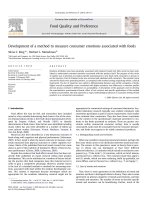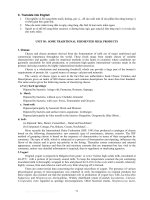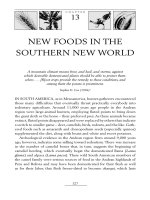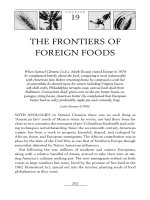Fermented foods
Bạn đang xem bản rút gọn của tài liệu. Xem và tải ngay bản đầy đủ của tài liệu tại đây (350.01 KB, 24 trang )
Fermented Foods
• Foods that have been subjected to the action of microorganisms or enzymes, in order to bring about a
desirable change.
• Numerous food products owe their production and
characteristics to the fermentative activities of
microorganisms.
• Fermented foods originated many thousands of years
ago when presumably micro-organism contaminated
local foods.
Fermented Foods
• Micro-organisms cause changes in the foods which:
– Help to preserve the food,
– Extend shelf-life considerably over that of the
raw materials from which they are made,
– Improve aroma and flavour characteristics,
– Increase its vitamin content or its digestibility
compared to the raw materials.
Table 1 History and origins of some fermented foods
Food
Mushrooms
Soy sauce
Wine
Fermented milk
Cheese
Beer
Bread
Fermented Meats
Sourdough bread
Fish sauce
Pickled vegetables
Tea
Approximate year
of introduction
4000 BC
3000 BC
3000 BC
3000 BC
2000 BC
2000 BC
1500 BC
1500 BC
1000 BC
1000 BC
1000 BC
200 BC
Region
China
China, Korea, Japan
North Africa, Europe
Middle East
Middle East
North Africa, China
Egypt, Europe
Middle East
Europe
Southeast Asia, North Africa
China, Europe
China
Fermented Foods
• The term “biological ennoblement” has
been used to describe the nutritional
benefits of fermented foods.
• Fermented foods comprise about onethird of the world wide consumption of
food and 20- 40 % (by weight) of
individual diets.
Table 2 Worldwide production of some fermented foods
Food
Quantity (t)
Beverage
Quantity (hl)
Cheese
15 million
Beer
1000 million
Yoghurt
3 million
Wine
350 million
Mushrooms
1.5 million
Fish sauce
300 000
Dried stockfish
250 000
Table 3 Individual consumption of some fermented
foods: average per person per year
Annual
Food
Country
consumption
Beer (I)
Wine (I)
Yoghurt (I)
Kimchi (kg)
Tempeh (kg)
Soy sauce (I)
Cheese (kg)
Miso (kg)
Germany
Italy, Portugal
Argentina
Finland
Netherlands
Korea
Indonesia
Japan
UK
Japan
130
90
70
40
25
22
18
10
10
7
Table 4 Benefits of fermentation
Benefit
Preservation
Enhancement of safety
Acid production
Acid and alcohol production
Production of bacteriocins
Removal of toxic components
Enhancement of nutritional value
Improved digestibility
Retention of micronutrients
Increased fibre content
Synthesis of probiotic compounds
Improvement of flavour
Raw
material
Fermented
food
Milk
Yoghurt, cheese
(Most materials)
Fruit
Barley
Grapes
Meat
Cassava
Soybean
Vinegar
Beer
Wine
Salami
Gari, polviho azedo
Soy sauce
Wheat
Leafy veges.
Coconut
Milk
Bread
Kimchi, sauerkraut
Nata de coco
Bifidus milk, Yakult,
Acidophilus yoghurt
Coffee
Wine
Coffee beans
Grapes
Cassava
•
•
•
Fresh cassava contains cyanhydric acid (HCN) that
should be eliminated from any product originating
from cassava to render it fit for human
QuickTime™ and a
(Uncompressed) decompressor
consumption. Depending on the production method TIFF
are needed to see this picture.
(particularly traditional methods) gari could
contains up to 20 mg / kg of HCN - against 43 mg /
kg for fresh peeled cassava.
Gari is a fermented, gelled and dehydrated food
produced from fresh cassava. It is a popular diet in
Nigeria, Benin, Togo, Ghana and in other West
Africa's countries. The consumption area even
expands to Central Africa: Gabon, Cameroon,
Congo Brazzaville and Angola.
Polvilho is a fine tapioca/manioc/cassava flour. it
can be found at latino markets in california as "sour
starch" (polvilho azedo) or "sweet starch" (polvilho
doce)
QuickTime™ and a
TIFF (Uncompressed) decompressor
are needed to see this picture.
Nata de Coco
•
•
•
•
•
A high fiber, zero fat Philippino dessert.
A chewy, translucent, jelly-like food product
produced by the bacterial fermentation of
coconut milk.
Commonly sweetened as a candy or dessert,
and can accompany many things including
pickles, drinks, ice cream, and fruit mixes.
Highly regarded for its high dietary fiber, and
its zero fat and cholesterol content.
It is produced through a series of steps ranging
from milk extraction, mixing, fermentation,
separating, cleaning, cutting to packaging.
QuickTime™ and a
TIFF (Uncompressed) decompressor
are needed to see this picture.
QuickTime™ and a
TIFF (Uncompressed) decompressor
are needed to see this picture.
Lactic Acid Bacteria
• Major group of Fermentative organisms.
• This group is comprised of 11 genera of gram-positive
bacteria:
• Carnobacterium, Oenococcus, Enterococcus,
Pediococcus, Lactococcus, Streptococcus, Lactobacillus,
Vagococcus, Lactosphaera, Weissells and Lecconostoc
• Related to this group are genera such as Aerococcus,
Microbacterium, and Propionbacterium.
Lactic Acid Bacteria
• While this is a loosely defined group with no precise boundaries
all members share the property of producing lactic acid from
hexoses.
• As fermenting organisms, they lack functional heme-linked
electron transport systems or cytochromes, they do not have a
functional Krebs cycle.
• Energy is obtained by substrate-level phosphorylation while
oxidising carbohydrates.
Lactic Acid Bacteria
• The lactic acid bacteria can be divided into two groups based on
the end products of glucose metabolism.
• Those that produce lactic acid as the major or sole product of
glucose fermentation are designated homofermentative.
• Those that produce equal amounts of lactic acid, ethanol and CO2
are termed heterofermentative.
• The homolactics are able to extract about twice as much energy
from a given quantity of glucose as the heterolactics.
Lactic Acid Bacteria
• All members of Pediococcus, Lactococcus, Streptococcus,
Vagococcus, along with some lactobacilli are
homofermenters.
• Carnobacterium, Oenococcus, Enterococcus, Lactosphaera,
Weissells and Lecconostoc and some Lactobacilli are
heterofermenters
• The heterolactics are more important than the homolactics in
producing flavour and aroma components such as
acetylaldehyde and diacetyl.
Lactic Acid Bacteria - Growth
• The lactic acid bacteria are mesophiles:
– they generally grow over a temperature range
of about 10 to 40oC,
– an optimum between 25 and 35oC.
– Some can grow below 5 and as high as 45 oC.
• Most can grow in the pH range from 4 to 8. Though some as
low as 3.2 and as high as 9.6.
Starter Cultures
• Traditionally the fermenting organisms came from the natural
microflora or a portion of the previous fermentation.
• In many cases the natural microflora is either inefficient,
uncontrollable, and unpredictable, or is destroyed during
preparation of the sample prior to fermentation (eg
pasteurisation).
• A starter culture can provide particular characteristics in a
more controlled and predictable fermentation.
Starter Cultures
• Lactic starters always include bacteria that convert
sugars to lactic acid, usually:
– Lactococcus lactis subsp. lactis,
– Lactococcus lactis subsp. cremoris or
– Lactococccus lactis subsp. lactis biovar diacetylactis.
•
Where flavour and aroma compounds such as diacetyl
are desired the lactic acid starter will include
heterofermentative organisms such as:
– Leuconostoc citrovorum or
– Leuconostoc dextranicum.
Starter Cultures
• The primary function of lactic starters is the production of
lactic acid from sugars
•
Other functions of starter cultures may include the
following:
• flavour, aroma, and alcohol production
• proteolytic and lipolytic activities
• inhibition of undesirable organisms
A good starter CULTURE will:
• Convert most of the sugars to lactic acid
• Increase the lactic acid concentration to
0.8 to 1.2 % (Titratable acidity)
• Drop the pH to between 4.3 to 4.5
• Food scientists frequently use the ability of
bacterial cells to grow and form colonies on solid
media to:
– isolate bacteria from foods,
– to determine what types and
– how many bacteria are present.
•
Streak plates
A single bacterial colony
The streak plate technique
• Bacteria are “streaked”over the surface of an agar plate
so as to obtain single colonies.
• Obtaining single colonies is important as it enables;
– the size,
– shape and
– colour of the individual colonies to be examined.
– It can also highlight the presence of contaminating
micro-organisms
The Streak Plate Technique
When conditions are right bacteria can double in number every
20 minutes
Microscopic examination
• Can provide information on the size
and shape of the bacteria
– Rods (1)
– Cocci (2)
– Spiral (3)
• It cannot provide enough information
to enable bacteria to be identified
Microscopic views of stained bacteria
Lactobacillus spp.
Lactococcus spp.









